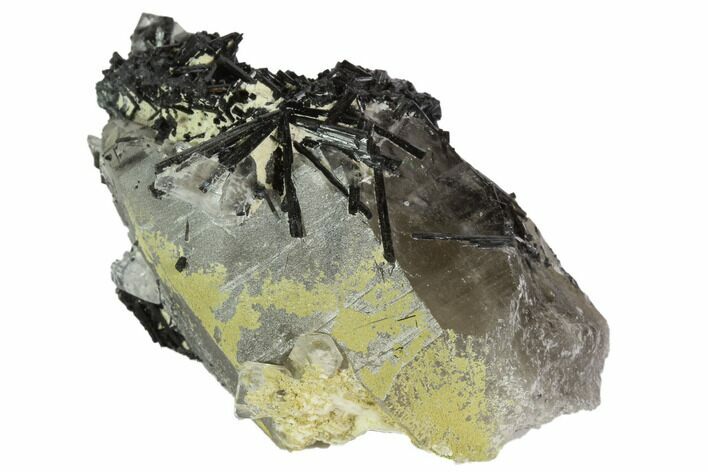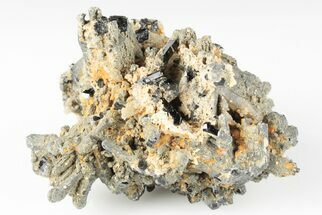This Specimen has been sold.
2.3" Black Tourmaline (Schorl) On Smoky Quartz - Namibia
This is an association of smoky quartz, goshenite and black tourmaline (schorl), collected from the Erongo Mountains in Namibia. The black tourmaline formed in and around the large smoky quartz crystal that's acts as the glue between this association. Goshenite crystals can be found scattered throughout the specimen as well.
Goshenite is a white to colorless variety of Beryl.
Tourmaline is a crystalline boron silicate mineral compounded with elements such as aluminium, iron, magnesium, sodium, lithium, or potassium. Schorl, or black tourmaline, is the most common form of tourmaline, and has been used for everything from jewelry to piezoelectric guitar pickups.
Goshenite is a white to colorless variety of Beryl.
Tourmaline is a crystalline boron silicate mineral compounded with elements such as aluminium, iron, magnesium, sodium, lithium, or potassium. Schorl, or black tourmaline, is the most common form of tourmaline, and has been used for everything from jewelry to piezoelectric guitar pickups.
Feldspars are a group of rock-forming tectosilicate minerals. They are the most common minerals on Earth, making up nearly 60% of the crust.
About Quartz
Quartz is the name given to silicon dioxide (SiO2) and is the second most abundant mineral in the Earth's crust. Quartz crystals generally grow in silica-rich environments--usually igneous rocks or hydrothermal environments like geothermal waters--at temperatures between 100°C and 450°C, and usually under very high pressure. In either case, crystals will precipitate as temperatures cool, just as ice gradually forms when water freezes. Quartz veins are formed when open fissures are filled with hot water during the closing stages of mountain formation: these veins can be hundreds of millions of years old.
Quartz is the name given to silicon dioxide (SiO2) and is the second most abundant mineral in the Earth's crust. Quartz crystals generally grow in silica-rich environments--usually igneous rocks or hydrothermal environments like geothermal waters--at temperatures between 100°C and 450°C, and usually under very high pressure. In either case, crystals will precipitate as temperatures cool, just as ice gradually forms when water freezes. Quartz veins are formed when open fissures are filled with hot water during the closing stages of mountain formation: these veins can be hundreds of millions of years old.
Smoky quartz is a grey-brown to black variety of quartz. This common name is derived from the appearance of smoke within the quartz crystal. Depending on the location and the chemicals present during formation, smoky quartz can appear opaque black, but it is typically translucent to some extent. It is believed that the quartz gains this color from a combination of natural irradiation and aluminum impurities.
SPECIES
Tourmaline var. Schorl, Quartz var. Smoky & Goshenite
LOCATION
Erongo Mountains, Namibia
SIZE
2.3" wide
CATEGORY
SUB CATEGORY
ITEM
#90687
 Reviews
Reviews













